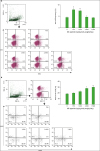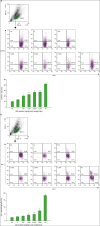1. Mandal A, Viswanathan C. Natural killer cells: in health and disease. Hematol Oncol Stem Cell Ther. 2015; 8:47–55.

2. Moretta L, Ciccone E, Moretta A, Höglund P, Ohlén C, Kärre K. Allorecognition by NK cells: nonself or no self? Immunol Today. 1992; 13:300–306.

3. Vivier E, Tomasello E, Baratin M, Walzer T, Ugolini S. Functions of natural killer cells. Nat Immunol. 2008; 9:503–510.

4. Glas R, Franksson L, Une C, Eloranta ML, Ohlén C, Örn A, Kärre K. Recruitment and activation of natural killer (NK) cells
in vivo determined by the target cell phenotype. An adaptive component of NK cell-mediated responses. J Exp Med. 2000; 191:129–138.

5. Smyth MJ, Crowe NY, Hayakawa Y, Takeda K, Yagita H, Godfrey DI. NKT cells - conductors of tumor immunity? Curr Opin Immunol. 2002; 14:165–171.

6. Walzer T, Dalod M, Robbins SH, Zitvogel L, Vivier E. Natural-killer cells and dendritic cells: “l'union fait la force”. Blood. 2005; 106:2252–2258.

7. Trinchieri G. Biology of natural killer cells. Adv Immunol. 1989; 47:187–376.

8. Vivier E, Ugolini S, Blaise D, Chabannon C, Brossay L. Targeting natural killer cells and natural killer T cells in cancer. Nat Rev Immunol. 2012; 12:239–252.

9. Nagai N, Murao T, Ito Y, Okamoto N, Sasaki M. Enhancing effects of sericin on corneal wound healing in Otsuka Long-Evans Tokushima fatty rats as a model of human type 2 diabetes. Biol Pharm Bull. 2009; 32:1594–1599.

10. Park D, Lee SH, Choi YJ, Bae DK, Yang YH, Yang G, Kim TK, Yeon S, Hwang SY, Joo SS, et al. Improving effect of silk peptides on the cognitive function of rats with aging brain facilitated by D-galactose. Biomol Ther (Seoul). 2011; 19:224–230.

11. Kim TK, Park D, Yeon S, Lee SH, Choi YJ, Bae DK, Yang YH, Yang G, Joo SS, Lim WT, et al. Tyrosine-fortified silk amino acids improve physical function of Parkinson's disease rats. Food Sci Biotechnol. 2011; 20:79–84.

12. Li P, Yin YL, Li D, Kim SW, Wu G. Amino acids and immune function. Br J Nutr. 2007; 98:237–252.

13. Guadagni M, Biolo G. Effects of inflammation and/or inactivity on the need for dietary protein. Curr Opin Clin Nutr Metab Care. 2009; 12:617–622.

14. Teramoto H, Kameda T, Tamada Y. Preparation of gel film from
Bombyx mori silk sericin and its characterization as a wound dressing. Biosci Biotechnol Biochem. 2008; 72:3189–3196.

15. Lee SH, Park D, Yang G, Bae DK, Yang YH, Kim TK, Kim D, Kyung J, Yeon S, Koo KC, et al. Silk and silkworm pupa peptides suppress adipogenesis in preadipocytes and fat accumulation in rats fed a high-fat diet. Eur J Nutr. 2012; 51:1011–1019.

16. Seo CW, Um IC, Rico CW, Kang MY. Antihyperlipidemic and body fat-lowering effects of silk proteins with different fibroin/sericin compositions in mice fed with high fat diet. J Agric Food Chem. 2011; 59:4192–4197.

17. Ahmad R, Kamra A, Hasnain SE. Fibroin silk proteins from the nonmulberry silkworm
Philosamia ricini are biochemically and immunochemically distinct from those of the mulberry silkworm
Bombyx mori
. DNA Cell Biol. 2004; 23:149–154.

18. Jung EY, Lee HS, Lee HJ, Kim JM, Lee KW, Suh HJ. Feeding silk protein hydrolysates to C57BL/KsJ-db/db mice improves blood glucose and lipid profiles. Nutr Res. 2010; 30:783–790.

19. Gotoh K, Izumi H, Kanamoto T, Tamada Y, Nakashima H. Sulfated fibroin, a novel sulfated peptide derived from silk, inhibits human immunodeficiency virus replication
in vitro. Biosci Biotechnol Biochem. 2000; 64:1664–1670.

20. Singh TM, Kadowaki MH, Glagov S, Zarins CK. Role of fibrinopeptide B in early atherosclerotic lesion formation. Am J Surg. 1990; 160:156–159.

21. Wang MS, Du YB, Huang HM, Zhu ZL, Du SS, Chen SY, Zhao HP, Yan Z. Silk fibroin peptide suppresses proliferation and induces apoptosis and cell cycle arrest in human lung cancer cells. Acta Pharmacol Sin. 2018.

22. Zhaorigetu S, Sasaki M, Watanabe H, Kato N. Supplemental silk protein, sericin, suppresses colon tumorigenesis in 1,2-dimethylhydrazine-treated mice by reducing oxidative stress and cell proliferation. Biosci Biotechnol Biochem. 2001; 65:2181–2186.

23. Kaewkorn W, Limpeanchob N, Tiyaboonchai W, Pongcharoen S, Sutheerawattananonda M. Effects of silk sericin on the proliferation and apoptosis of colon cancer cells. Biol Res. 2012; 45:45–50.

24. Uff CR, Scott AD, Pockley AG, Phillips RK. Influence of soluble suture factors on
in vitro macrophage function. Biomaterials. 1995; 16:355–360.

25. Cui X, Wen J, Zhao X, Chen X, Shao Z, Jiang JJ. A pilot study of macrophage responses to silk fibroin particles. J Biomed Mater Res A. 2013; 101:1511–1517.

26. Betts MR, Brenchley JM, Price DA, De Rosa SC, Douek DC, Roederer M, Koup RA. Sensitive and viable identification of antigen-specific CD8+ T cells by a flow cytometric assay for degranulation. J Immunol Methods. 2003; 281:65–78.

27. Aktas E, Kucuksezer UC, Bilgic S, Erten G, Deniz G. Relationship between CD107a expression and cytotoxic activity. Cell Immunol. 2009; 254:149–154.

28. Aubry JP, Blaecke A, Lecoanet-Henchoz S, Jeannin P, Herbault N, Caron G, Moine V, Bonnefoy JY. Annexin V used for measuring apoptosis in the early events of cellular cytotoxicity. Cytometry. 1999; 37:197–204.

29. Hayakawa Y, Huntington ND, Nutt SL, Smyth MJ. Functional subsets of mouse natural killer cells. Immunol Rev. 2006; 214:47–55.

30. Chiossone L, Chaix J, Fuseri N, Roth C, Vivier E, Walzer T. Maturation of mouse NK cells is a 4-stage developmental program. Blood. 2009; 113:5488–5496.

31. Artym J, Zimecki M, Paprocka M, Kruzel ML. Orally administered lactoferrin restores humoral immune response in immunocompromised mice. Immunol Lett. 2003; 89:9–15.

32. Kuhara T, Yamauchi K, Tamura Y, Okamura H. Oral administration of lactoferrin increases NK cell activity in mice via increased production of IL-18 and type I IFN in the small intestine. J Interferon Cytokine Res. 2006; 26:489–499.

33. Egusa S, Otani H. Soybean protein fraction digested with neutral protease preparation, “Peptidase R”, produced by
Rhizopus oryzae, stimulates innate cellular immune system in mouse. Int Immunopharmacol. 2009; 9:931–936.

34. Chang H, Jin BR, Jang YS, Kim WS, Kim PH. Lactoferrin stimulates mouse macrophage to express BAFF via Smad3 pathway. Immune Netw. 2012; 12:84–88.

35. Moon JH, Pyo KH, Jung BK, Chun HS, Chai JY, Shin EH. Resistance to
Toxoplasma gondii infection in mice treated with silk protein by enhanced immune responses. Korean J Parasitol. 2011; 49:303–308.

36. Igarashi K, Yoshioka K, Mizutani K, Miyakoshi M, Murakami T, Akizawa T. Blood pressure-depressing activity of a peptide derived from silkworm fibroin in spontaneously hypertensive rats. Biosci Biotechnol Biochem. 2006; 70:517–520.

37. Ikegawa Y, Sato S, Lim G, Hur W, Tanaka K, Komori M, Takenaka S, Taira T. Amelioration of the progression of an atopic dermatitis-like skin lesion by silk peptide and identification of functional peptides. Biosci Biotechnol Biochem. 2012; 76:473–477.

38. Gerberick GF, Cruse LW, Ryan CA. Local lymph node assay: differentiating allergic and irritant responses using flow cytometry. Methods. 1999; 19:48–55.

39. Sikorski EE, Gerberick GF, Ryan CA, Miller CM, Ridder GM. Phenotypic analysis of lymphocyte subpopulations in lymph nodes draining the ear following exposure to contact allergens and irritants. Fundam Appl Toxicol. 1996; 34:25–35.

40. Min B, Choi H, Her JH, Jung MY, Kim HJ, Jung MY, Lee EK, Cho SY, Hwang YK, Shin EC. Optimization of large-scale expansion and cryopreservation of human natural killer cells for anti-tumor therapy. Immune Netw. 2018; 18:e31.

41. Wang R, Jaw JJ, Stutzman NC, Zou Z, Sun PD. Natural killer cell-produced IFN-γ and TNF-α induce target cell cytolysis through up-regulation of ICAM-1. J Leukoc Biol. 2012; 91:299–309.










 PDF
PDF Citation
Citation Print
Print



 XML Download
XML Download